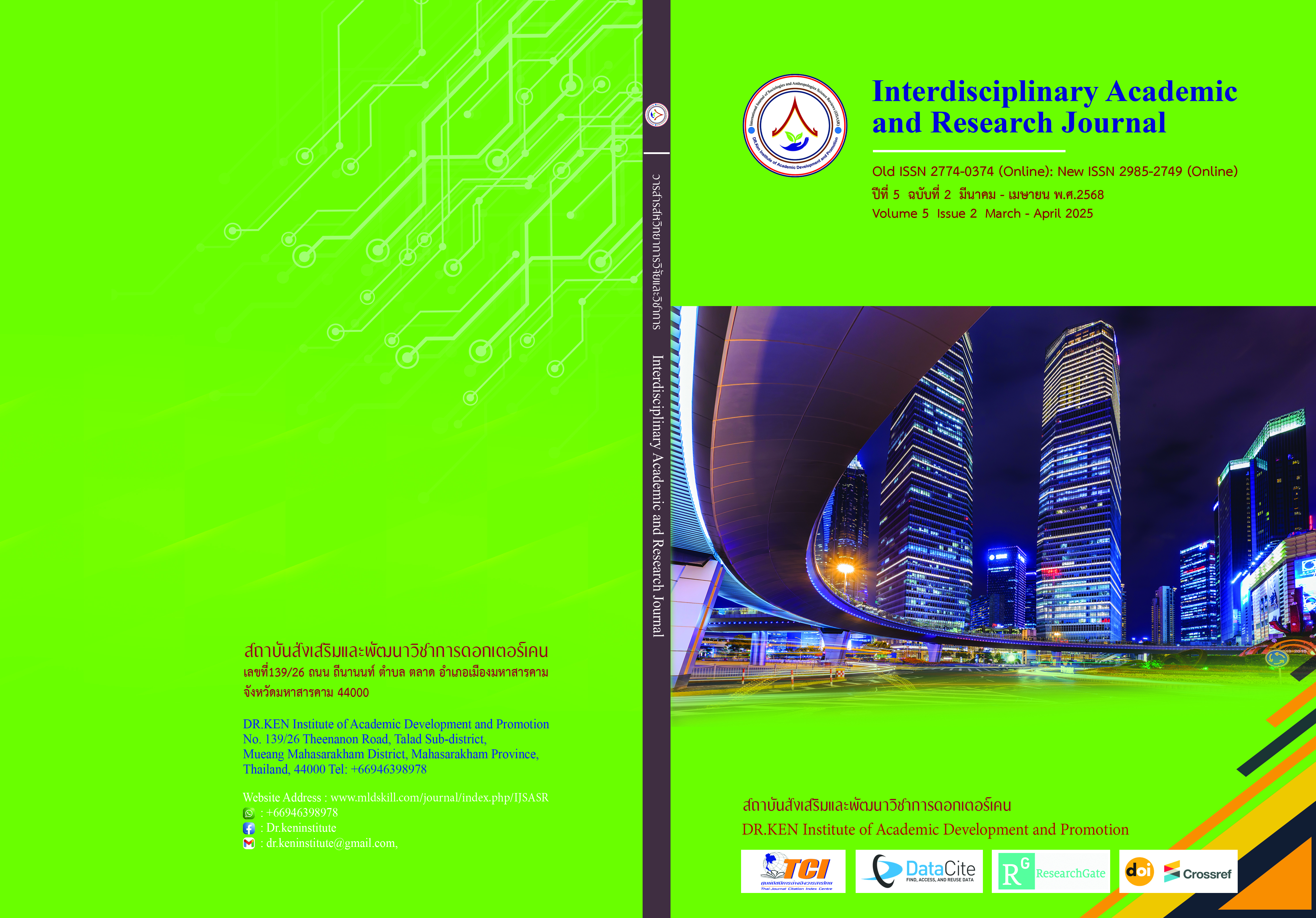The Development Model of Teacher Servant Leadership Under Mahasarakham Primary Educational Service Area Office 1
DOI:
https://doi.org/10.60027/iarj.2025.281594Keywords:
Development Model, Teacher Servant LeadershipAbstract
Background and Aims: A teacher with a servant leadership approach is an individual who strives to achieve goals through actions that prioritize student development. This approach places students as the top priority, providing opportunities for their growth and success. The teacher is supportive, fostering, and encouraging each student to develop according to their potential. Therefore, the objectives of this research are as follows: 1) to study the components and indicators of servant leadership of teachers. 2) to study the current situation, desirable condition and needs assessment of servant leadership of teachers. 3) create a model for developing servant leadership of teachers. 4) to study the results of using the servant leadership development of teachers.
Methodology: The research was divided into four phases: Phase 1 studied components and indicators of servant leadership of teachers. The key informant group was 7 experts to confirm the components and indicators. Phase 2) studied the current situation, desirable condition and needs assessment of servant leadership of teachers. The sample group consisted of 297 school administrators and teachers. The research tool was a questionnaire with a reliability of .93. Data were analyzed by means and standard deviation Phase 3 created a model for developing servant leadership of teachers. The key informant group was 6 experts to study best practices and 9 experts to confirm the model by connoisseurship. Phase 4 studied the results of using the servant leadership development of teachers. The target groups were 20 teachers.
Results: 1. The components and indicators of servant leadership of teachers, consisted of 5 components, Including 1) Building trust 2) Foresight 3) Commitment to the growth of people 4) Value people 5) Building community. 2. The overall current condition is at a high average level. The overall desirable condition was at the highest mean level. The Needs assessment was ranked from highest to lowest as follows: 1) Building trust 2) Foresight 3) Commitment to the growth of people 4) Value people 5) Building community. 3. The development format consists of 5 modules: Module 1 Building Trust, Module 2 Foresight, Module 3, Commitment to the Growth of People Module 4Value People, Module 5 Building Community. The overall assessment results indicate that the appropriateness, feasibility, and benefits of the format are at the highest level. 4. The results from using Format 1) The overall assessment of the leadership service-oriented teacher in terms of changes in leadership levels, the average level is the highest in all aspects, with the highest average result level. 2) Satisfaction with the use of formats has the highest average level.
Conclusion: Teacher-servant leadership fosters mutual acceptance within the organization, promotes unity, and encourages collaboration, as everyone is instilled with a sense of service toward one another. This creates a positive atmosphere, leading to love and solidarity within the organization. The key components of this leadership approach are: 1) valuing people, 2) building a community, 3) commitment to the growth of people, 4) foresight, and 5) building trust.
References
ธีระศักดิ์ คำดำและ ดาวรุวรรณ ถวิลการ. (2560). ภาวะผู้นำใฝ่บริการของนักวิชาการที่ส่งผลต่อการบริการที่ดีในสำนักงานเขตพื้นที่การศึกษาประถมศึกษา สังกัดกลุ่มจังหวัดร้อยแก่นสารสินธุ์. วารสารวิทยบริการ มหาวิทยาลัยสงขลานครินทร์, 28(3), 48-56.
บุญจันทร์ สีสันต์. (2557). การวิเคราะห์องค์ประกอบคุณลักษณะผู้นำแบบรับใช้ของครู สังกัดสำนักงานคณะกรรมการการอาชีวศึกษา กระทรวงศึกษาธิการ. วารสารครุศาสตร์อุตสาหกรรม. 3(2), 58-65.
วิโรจน์ สารรัตนะ. (2557). ภาวะผู้นำ : ทฤษฎีและนานาทัศนะร่วมสมัยปัจจุบัน. กรุงเทพฯ : ทิพย์วิสุทธ์.
สำนักงานคณะกรรมการการศึกษาขั้นพื้นฐาน. (2565). แผนพัฒนาการศึกษาขั้นพื้นฐาน (พ.ศ. 2566 - 2570). กรุงเทพฯ : สำนักงานคณะกรรมการการศึกษาขั้นพื้นฐาน.
สำนักงานเลขาธิการสภาการศึกษา. (2565). รายงานการศึกษาการพัฒนารูปแบบการจัดระบบนิเวศการเรียนรู้ที่เอื้อต่อการพัฒนาศักยภาพของคนไทย 4.0. กรุงเทพฯ : สำนักงานเลขาธิการสภาการศึกษา กระทรวงศึกษาธิการ.
สุวิมล ว่องวาณิช. (2558). การวิจัยประเมินความต้องการจําเป็น (พิมพ์ครั้งที่ 3). กรุงเทพฯ: วี.พริ้นท์ (1991).
อัญชลี ชัยชนะวิจิตร. (2553). สุดยอดผู้นำคือผู้รับใช้. กรุงเทพฯ: สยามอินเตอร์บุ๊ค.
Anderson, J.D., (2006). Servant Leadership in public schools: A case study. Doctoral dissertation (Ed.D.). University of Missouri-Columbia.
Center for Creative Leadership. (2020). Leading from the top requires a critical shift in perspective. Retrieved from, https://www.ccl.org/leadership-programs/virtualleadership-development-programs/
Cerit, Y. (2011). The effects of servant leadership behaviors of school principals on teacher job satisfaction. Educational Management Administration & Leadership. 37, 600-623.
Daft, R.L. (2002). The Leadership Experience. 2nd edition. Fort Worth, Tx: Harcourt, College.
Dubrin, A.J. (2007). Leadership: Research Findings, Practice, and Skill. 5th edition. Boston: Houghton Mifflin Company.
Greenleaf, R.K. (2002). Servant Leadership: A Journey into the Nature of Legitimate Power and Greatness. NJ: Paulist Press.
Hays, J. M. (2008). Teacher as servant applications of Greenleaf's servant leadership in higher education. Journal of Global Business Issues, 2(1), 113–134.
Hunter, E. M., Neubert, M. J., Perry, S. J., Witt, L. A., Penney, L. M., & Weinberger, E. (2013). Servant leaders inspire servant followers: Antecedents and outcomes for employees and the organization. Leadership Quarterly, 24(2), 316-331.
Krejcie, R. V., & Morgan, D. W. (1970). Determining sample size for research activities. Educational and Psychological Measurement, 30(3), 607–610.
Longmire, J. (2024). Teacher as a Servant: Servant Leadership in the Classroom. Retrieved from https://www.dbu.edu/news/2024/02/teacher-as-a-servant.html
McCall, M. (1996). What’s the 70:20:10 Learning Model?. Retrieved from https://elmlearning.com/why-everyone-should-just-stop-it-with-the-70-20-10- model/.
Northouse, P. G. (2013). Leadership: Theory and Practice. 6th edition. Thousand Oaks, CA: Sage Publications.
Patterson, K. (2003). Servant leadership: A theoretical model. Doctoral dissertation. Regent University, Virginia Beach, VA. USA.
Pounder, J.S. (2008). Transformational classroom leadership: A novel approach to evaluating classroom performance. Assessment & Evaluation in Higher Education, 33, 233-243. doi: 10.1080/02602930701292621
Spears, L. C. (2004). The Understanding and Practice of Servant - leadership. In L.C. Spears, & M. Lawrence (Eds), Practicing servant leadership: Succeeding.
Downloads
Published
How to Cite
Issue
Section
License
Copyright (c) 2025 Interdisciplinary Academic and Research Journal

This work is licensed under a Creative Commons Attribution-NonCommercial-NoDerivatives 4.0 International License.
Copyright on any article in the Interdisciplinary Academic and Research Journal is retained by the author(s) under the under the Creative Commons Attribution-NonCommercial-NoDerivatives 4.0 International License. Permission to use text, content, images, etc. of publication. Any user to read, download, copy, distribute, print, search, or link to the full texts of articles, crawl them for indexing, pass them as data to software, or use them for any other lawful purpose. But do not use it for commercial use or with the intent to benefit any business.














.png)

